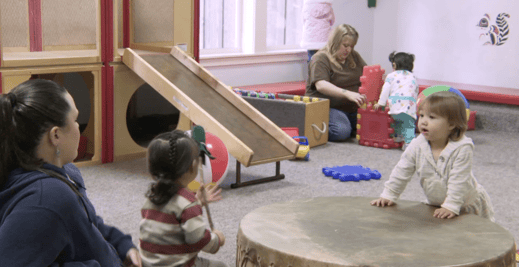
In every CLASS Observation Training, there is always one video that is my favorite. I know--they say we aren’t supposed to have favorites, but when it comes to training videos, I just can’t help myself!
Floor Drum is the fourth video in the Toddler CLASS Observation Training and it's my favorite. Did you know that the video sequence in every observation training is totally intentional? That’s right, there is very specific rationale behind the order of the training videos, and each video accomplishes a different goal. It creates a purposeful journey for CLASS observation training participants!
Floor Drum is an important video because it pushes participants past their biases. Being a reliable CLASS Observer is all about being able to observe and code objectively according to CLASS. What better way to transform participants into being objective than to have them observe a video that challenges personal bias and objectivity?
As a trainer, here are three reasons why I believe Floor Drum is a valuable toddler CLASS Observation Training video:
1. Surprise! There are effective interactions in Floor Drum
Floor Drum challenges participants to recognize effective behaviors. During facilitation of this video, I will say, “Share some evidence you saw for this dimension ...”. Participants always seem to share the less effective pieces of evidence first--the interactions they didn't like. Having regard for participants' perspectives, I always allow participants to share these opinions respectfully. However, I normally have to guide the group back to the objective evidence they noted in the video, including evidence across all levels of effectiveness. The truth is that even though Floor Drum is not a consistently effective video, it is mixed in its effective moments, which means there are some effective behaviors--and it is important for participants to identify them.
2. The setting is not a traditional classroom
In Texas, our early childhood settings often have rooms in the building with names like “Gross-Motor Room” or “Soft-Motor Room.” In the Floor Drum video, the group is in a gross-motor room, which is great! It teaches participants that CLASS observations can be done everywhere throughout the day. Gross-motor rooms can look like a form of free time, but just because free time is taking place, doesn’t always mean that quality interactions shouldn't be present throughout the cycle. Participants can see the potential for quality interactions outside of their personal ideas of a traditional classroom.
3. There are two teachers!
I love videos with two teachers because it helps us to remember that CLASS is not a teacher assessment, it is a classroom assessment. We typically observe all the adults in the classroom but have to make judgments about how much to weigh their interactions and impact across a cycle. During the video, participants have to weigh the interactions of both adults. Figuring out how to weigh teachers can be a challenge, but Floor Drum affords participants valuable practice in considering two teachers’ contributions and interactions in one classroom setting.
Floor Drum will always be my favorite video for the Toddler CLASS Observation Training! It reminds participants to think about what CLASS considers to be effective, rather than what they may personally consider to be effective. It might be a tough realization, but once the challenge has been overcome, becoming objective and putting on the CLASS lens can be a rewarding process!
Tell us what strategies you use when facilitating the toddler video, Floor Drum!

